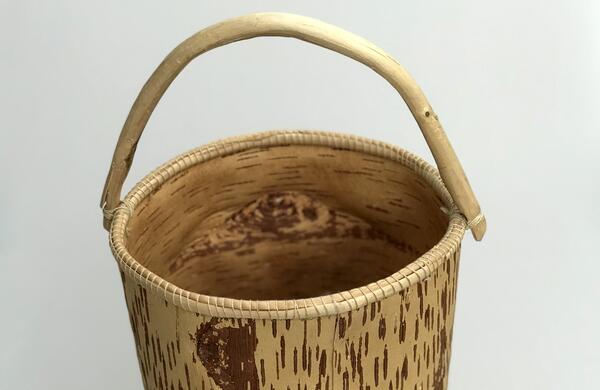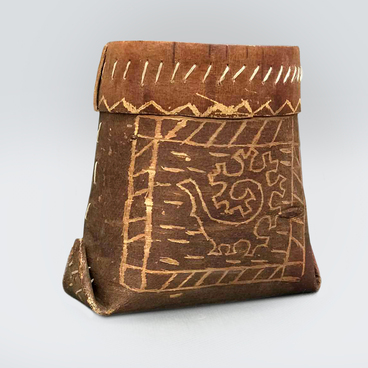The Khanty and Mansi peoples often use birch bark for manufacturing various household items. This material is also used nowadays in order to produce different items, both for sale and for own use. Birch bark is used to make boxes of different sizes, snuffboxes, ‘nabirushki’ (baskets for berry picking), various tableware, and even buckets. The berries growing low are collected in baskets with handles that are convenient in use. When people go to pick the berries that grow high, such as raspberry, they usually take another type of basket to be hung around the neck. Birch bark flat-bottomed waterproof vessels with low walls were used for storing raw fish, meat, and liquids. In the old days, a large shoulder basket was used for carrying small children.
Birch bark for making household items is usually collected by women. Men collect birch bark for larger works, such as covering a house. Birch bark is collected three times a year: in early spring, in summer, when the rosehip blooms, and in autumn, when the leaves fall. To get the best birch bark, the artisans choose the trees that grow deep in the forest, among high aspen trees, because the trunk of such trees is usually tall and smooth.
After making several incisions, birch bark is removed from the tree by hands. Then the material is processed depending on the further purpose. The bark is cleaned and put under a press in a cool, dark place, not to dry out and to retain flexibility and elasticity. For the production of tableware, hunting decoys, and other small items, the white pellicle is removed from the birch bark and cut into pieces of the desired shape and size. For the construction of a boat or covering a dwelling, large panels are sewn from birch bark.
The bark is boiled in water, sometimes fish oil is added. Birch bark is put vertically in a large pot, tightly covered with moss and fir tree bark. Thus, it is boiled on a fire for at least a day. Modern artisans sew the finished material using an ordinary awl, while in old times, the so-called puncture made from the rib of a young deer or elk was used for this purpose.
Birch bark products are decorated with all kinds of traditional ornaments. They are applied in different techniques such as scratching, embossing, openwork carving, piercing, or stamping.
Birch bark for making household items is usually collected by women. Men collect birch bark for larger works, such as covering a house. Birch bark is collected three times a year: in early spring, in summer, when the rosehip blooms, and in autumn, when the leaves fall. To get the best birch bark, the artisans choose the trees that grow deep in the forest, among high aspen trees, because the trunk of such trees is usually tall and smooth.
After making several incisions, birch bark is removed from the tree by hands. Then the material is processed depending on the further purpose. The bark is cleaned and put under a press in a cool, dark place, not to dry out and to retain flexibility and elasticity. For the production of tableware, hunting decoys, and other small items, the white pellicle is removed from the birch bark and cut into pieces of the desired shape and size. For the construction of a boat or covering a dwelling, large panels are sewn from birch bark.
The bark is boiled in water, sometimes fish oil is added. Birch bark is put vertically in a large pot, tightly covered with moss and fir tree bark. Thus, it is boiled on a fire for at least a day. Modern artisans sew the finished material using an ordinary awl, while in old times, the so-called puncture made from the rib of a young deer or elk was used for this purpose.
Birch bark products are decorated with all kinds of traditional ornaments. They are applied in different techniques such as scratching, embossing, openwork carving, piercing, or stamping.


